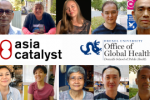[:en]Remarks by Joanne Csete at launching of Asia Catalyst’s report I Will Fight to My Last Breath: Barriers to AIDS Treatment in China on April 28, 2009.
I would like to offer these remarks in honor of our colleague Mr Hu Jia who is currently in a Chinese prison partly because he exercised his freedom of speech in the form of bold advocacy on behalf of people living with HIV in China. I am also deeply honored to be in the presence of Mr Li Dan and Ms. Shen Tingting and to acknowledge their pioneering work on behalf of people living with HIV.
I congratulate Asia Catalyst on the hard work that went into the production of this very useful report and especially for reminding us that addressing HIV in any population means addressing a wide range of human rights and human rights abuses.
We are in a moment in the global health world when there are many powerful interests making the case that the world has focused too much on HIV, that HIV has been treated as too “special” and has received too much money and attention, and that we need to make our response to HIV more like the response to other health problems. My reaction when I hear this is that this line of argument opens the door for those who would push us back to the time when all global health problems were horribly underfunded and neglected. Why are we not all pushing for every health problem and for health systems challenges to attract the kind of funding that HIV/AIDS has attracted, rather than for HIV to be pushed back into the “normalcy” of other problems?
In any case, this report reminds us of several ways in which HIV, whatever might be said about the response to it, really is special as a health problem. The very fact that its transmission is related to sex and drugs has meant from the beginning – and even now – that HIV is associated in the public mind with drug injection, sexual promiscuity, sex work, and homosexuality. In many societies, people who turn up with HIV, no matter who they are, are readily assumed to be promiscuous or unfaithful or secretly gay or clandestine drug addicts. Thus a central challenge for HIV responses everywhere has been how to mount programs in an environment of stigma, blame and social exclusion because sex and drugs is the context.
In many countries, the only “innocent” or “blameless” “victims” of HIV in public and too often policy-level thinking are people who acquired HIV through a blood transfusion like the eponymous Ryan White in the US (for whom domestic AIDS legislation in this country is named) and children who got the disease by the simple fact of being born to someone living with HIV. You would think, then, that children would be a policy priority, but, as this report shows, the stigma and moral judgmentalness and blame associated with HIV is so strong that children are still tarred with it in spite of their “innocence” with respect to transmission.
And at this point we run up against a second aspect of HIV that is special, compared at least to other infectious disease pandemics. Most such diseases preferentially target young children and the elderly – they are immunologically and in other ways most vulnerable. But HIV claims the lives of adults in the prime of life, many of whom are parents, and many of those are parents of young children. This means that those people who are the most effective advocates for getting children’s problems onto the political agenda – namely their parents – are in the case of HIV often struggling just to survive, are sick, dying or dead.
In China, advocacy on behalf of anyone – child or adult – affected by HIV is further complicated by a factor special to the country (as Meg explained), which is that the government has consistently sought to suppress the history of massive HIV infection through state-run blood plasma collections, of which we are likely never to know the true scale and the true cost in lives. This history has made HIV even more taboo in public discourse, as though sex and drugs didn’t make it taboo enough.
In addition to all of these factors, it must be said that it is shocking that China, which has in recent years been so widely praised for accelerating its AIDS response, has apparently done so little on educating the public about the basics of HIV transmission that there is still widespread belief that HIV is spread through casual contact. And that belief is one of the most effective ways to reinforce fear and discrimination against people living with the disease, including children.
So in this context, we begin perhaps to imagine how difficult it is to advance any human rights-based policy responses to HIV, including an assurance of pediatric treatment, an assurance that China certainly has the resources to make. This report is an excellent example of using human rights commitments, of which China remarkably has made many with respect to international human rights treaties, to advocate for universal access to basic services for children and, further,
to assert that services should reflect respect for the inherent dignity of these children, their family and all people affected by HIV. The detailed descriptions in the report of how the lack of access to basic care further impoverishes already poor people, and adds insult to the injury of HIV-based stigma and exclusion, provide
important fodder for continued advocacy.
The report calls on China to meet the need for treating children at least partly by making use of compulsory licensing, which means issuing a temporary license to produce a drug that is under patent without the consent of the patent-holder but with some level of compensation to the patent-holder. This is a measure allowed by the World Trade Organization rules in cases of meeting a public health need. It’s a good recommendation, and something that should be tried.
In addition, though, we might note that there is growing dissatisfaction with the difficulties of using compulsory licensing for life-saving medicines under the terms of the WTO rules. These difficulties have led many experts and organizations to suggest that the next major battle in access to medicines is finding measures that are not outgrowths of the global patent system (like compulsory licensing) but rather fundamental alternatives to conventional patents. Thus we have a new global discussion about things like patent pooling, which is what it sounds like – an arrangement for the collective management of patent rights, which usually involves a group of patent holders cross-licensing their patents to others, and which could, for example, be managed by a non-profit entity in a non-profit way. This idea was raised with respect
to life-saving medicines in the World Health Assembly’s 2008 statement on intellectual property and health, and it has been endorsed by UNITAID, which is a non-profit agency created with monies from a small tax on airline tickets in Europe that is meant to be a large-scale purchaser of medicines for use in developing countries.
In addition to patent pools, many groups are calling for a global system of one-time prizes for innovations in the area of medicines that would provide compensation for discoverers of new drugs but would not be associated with the 20-year monopolies associated with patents that inevitably drive up prices and restrict access. I am sure that we will all have opportunities in the coming months and years to educate ourselves on these alternatives and to support structural changes in global intellectual property regulation that could facilitate access to life-saving medicines in ways that the current patent system fails to do.
All of which is to say that while the victories that have led to dramatic declines in the prices of life-saving medicines, which are largely due to AIDS activists asserting the human right of all people to affordable care, these victories are really only the beginning. There is much more to be done, and China’s actions and those of Chinese activists and their supporters will be important in this struggle.
Finally let me say that this report is a tribute to the courage of people affected by HIV and their advocates in China. It has been hard enough in places where human rights are enshrined in national law to achieve the victories of rights-based advocacy in national responses to HIV – that is, progress on the affordability of treatment; and progress (though never enough) in reducing stigma; progress in ensuring any level of protection for the human rights of those most affected by HIV – including children, people who use illicit drugs, people in the sex trade, gay and bisexual men, women facing domestic violence and other forms of subordination; and, eventually, ensuring that the voices of all those people are heard in policy and program decision-making. Indeed hard enough in those places where there is some tradition of strong human rights mechanisms, but enormously difficult in China. That there has been any progress whatsoever in these areas in China – and there has – is a testament to astonishingly brave activists who have faced abuse, imprisonment and repression to assert the rights of those affected by and vulnerable to HIV.
So this report and this event, I hope, are reminders that we need to do everything we can to support organizations like Asia Catalyst that are basing their AIDS advocacy on the proven idea that acting to safeguard the human rights of those affected by and vulnerable to HIV must be a central public health strategy with respect to this disease. I congratulate Asia Catalyst again on this work and add my thanks to all of you for being here.[:zh]Remarks by Joanne Csete at launching of Asia Catalyst’s report I Will Fight to My Last Breath: Barriers to AIDS Treatment in China on April 28, 2009.
I would like to offer these remarks in honor of our
colleague Mr Hu Jia who is currently in a Chinese prison partly because he
exercised his freedom of speech in the form of bold advocacy on behalf of
people living with HIV in China. I am also deeply honored to be in the
presence of Mr Li Dan and Ms. Shen Tingting and to acknowledge their pioneering
work on behalf of people living with HIV.
I congratulate Asia Catalyst on the hard work that went into
the production of this very useful report and especially for reminding us that
addressing HIV in any population means addressing a wide range of human rights
and human rights abuses.
We are in a moment in the global health world when there are
many powerful interests making the case that the world has focused too much on
HIV, that HIV has been treated as too “special” and has received too much money
and attention, and that we need to make our response to HIV more like the
response to other health problems. My
reaction when I hear this is that this line of argument opens the door for
those who would push us back to the time when all global health problems were
horribly underfunded and neglected. Why
are we not all pushing for every health problem and for health systems
challenges to attract the kind of funding that HIV/AIDS has attracted, rather
than for HIV to be pushed back into the “normalcy” of other problems?
In any case, this report reminds us of several ways in which
HIV, whatever might be said about the response to it, really is special as a
health problem. The very fact that its
transmission is related to sex and drugs has meant from the beginning – and
even now – that HIV is associated in the public mind with drug injection,
sexual promiscuity, sex work, and homosexuality. In many societies, people who turn up with
HIV, no matter who they are, are readily assumed to be promiscuous or
unfaithful or secretly gay or clandestine drug addicts. Thus a central challenge for HIV responses
everywhere has been how to mount programs in an environment of stigma, blame
and social exclusion because sex and drugs is the context.
In many countries, the only “innocent” or “blameless”
“victims” of HIV in public and too often policy-level thinking are people who
acquired HIV through a blood transfusion like the eponymous Ryan White in the
US (for whom domestic AIDS legislation in this country is named) and children
who got the disease by the simple fact of being born to someone living with
HIV. You would think, then, that
children would be a policy priority, but, as this report shows, the stigma and
moral judgmentalness and blame associated with HIV is so strong that children
are still tarred with it in spite of their “innocence” with respect to
transmission.
And at this point we run up against a second aspect of HIV
that is special, compared at least to other infectious disease pandemics. Most such diseases preferentially target
young children and the elderly – they are immunologically and in other ways
most vulnerable. But HIV claims the
lives of adults in the prime of life, many of whom are parents, and many of
those are parents of young children.
This means that those people who are the most effective advocates for
getting children’s problems onto the political agenda – namely their parents –
are in the case of HIV often struggling just to survive, are sick, dying or
dead.
In China, advocacy on behalf of anyone – child or adult –
affected by HIV is further complicated by a factor special to the country (as
Meg explained), which is that the government has consistently sought to
suppress the history of massive HIV infection through state-run blood plasma
collections, of which we are likely never to know the true scale and the true
cost in lives. This history has made HIV
even more taboo in public discourse, as though sex and drugs didn’t make it
taboo enough.
In addition to all of these factors, it must be said that it
is shocking that China, which has in recent years been so widely praised for
accelerating its AIDS response, has apparently done so little on educating the
public about the basics of HIV transmission that there is still widespread
belief that HIV is spread through casual contact. And that belief is one of the most effective
ways to reinforce fear and discrimination against people living with the
disease, including children.
So in this context, we begin perhaps to imagine how
difficult it is to advance any human rights-based policy responses to HIV,
including an assurance of pediatric treatment, an assurance that China certainly
has the resources to make. This report
is an excellent example of using human rights commitments, of which China
remarkably has made many with respect to international human rights treaties,
to advocate for universal access to basic services for children and, further,
to assert that services should reflect respect for the inherent dignity of
these children, their family and all people affected by HIV. The detailed descriptions in the report of
how the lack of access to basic care further impoverishes already poor people,
and adds insult to the injury of HIV-based stigma and exclusion, provide
important fodder for continued advocacy.
The report calls on China to meet the need for treating
children at least partly by making use of compulsory licensing, which
means issuing a temporary license to produce a drug that is under patent
without the consent of the patent-holder but with some level of compensation to
the patent-holder. This is a measure
allowed by the World Trade Organization rules in cases of meeting a public
health need. It’s a good recommendation,
and something that should be tried.
In addition, though, we might note that there is growing
dissatisfaction with the difficulties of using compulsory licensing for life-saving
medicines under the terms of the WTO rules.
These difficulties have led many experts and organizations to suggest
that the next major battle in access to medicines is finding measures that are
not outgrowths of the global patent system (like compulsory licensing) but
rather fundamental alternatives to conventional patents. Thus we have a new global discussion about
things like patent pooling, which is what it sounds like – an
arrangement for the collective management of patent rights, which usually
involves a group of patent-holders cross-licensing their patents to others, and
which could, for example, be managed by a non-profit entity in a non-profit
way. This idea was raised with respect
to life-saving medicines in the World Health Assembly’s 2008 statement on intellectual
property and health, and it has been endorsed by UNITAID, which is a non-profit
agency created with monies from a small tax on airline tickets in Europe that is meant to be a large-scale purchaser of
medicines for use in developing countries.
In addition to patent pools, many groups are calling for a
global system of one-time prizes for innovations in the area of medicines that
would provide compensation for discoverers of new drugs but would not be
associated with the 20-year monopolies associated with patents that inevitably
drive up prices and restrict access. I
am sure that we will all have opportunities in the coming months and years to
educate ourselves on these alternatives and to support structural changes in
global intellectual property regulation that could facilitate access to
life-saving medicines in ways that the current patent system fails to do.
All of which is to say that while the victories that have
led to dramatic declines in the prices of life-saving medicines, which are
largely due to AIDS activists asserting the human right of all people to
affordable care, these victories are really only the beginning. There is much more to be done, and China’s actions
and those of Chinese activists and their supporters will be important in this
struggle.
Finally let me say that this report is a tribute to the
courage of people affected by HIV and their advocates in China. It has been hard enough in places where human
rights are enshrined in national law to achieve the victories of rights-based
advocacy in national responses to HIV – that is, progress on the affordability
of treatment; and progress (though never enough) in reducing stigma; progress
in ensuring any level of protection for the human rights of those most affected
by HIV – including children, people who use illicit drugs, people in the sex
trade, gay and bisexual men, women facing domestic violence and other forms of
subordination; and, eventually, ensuring that the voices of all those people
are heard in policy and program decision-making. Indeed hard enough in those places where
there is some tradition of strong human rights mechanisms, but enormously
difficult in China. That there has been any progress whatsoever
in these areas in China
– and there has – is a testament to astonishingly brave activists who have
faced abuse, imprisonment and repression to assert the rights of those affected
by and vulnerable to HIV.
So this report and this event, I hope, are reminders that we
need to do everything we can to support organizations like Asia Catalyst that
are basing their AIDS advocacy on the proven idea that acting to safeguard the
human rights of those affected by and vulnerable to HIV must be a central
public health strategy with respect to this disease. I congratulate Asia Catalyst again on this
work and add my thanks to all of you for being here.
[:]




